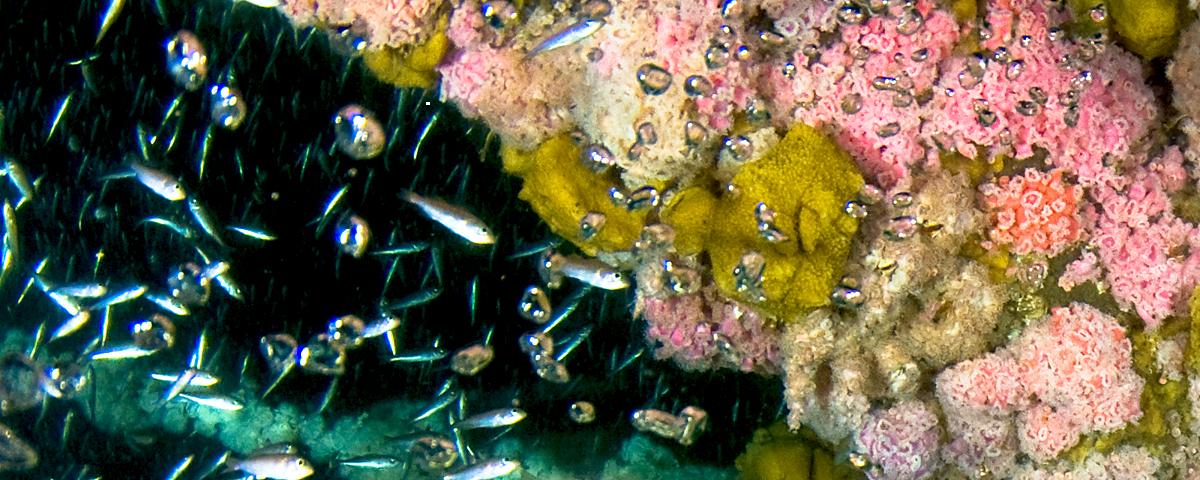Determining the geographic distribution, maximum depth, and genetic affinities of corals on offshore platforms, northern Gulf of Mexico
Abstract
From Significant Conclusions and Study Results
“Corals occurred on many of the platforms in the northern GOM. Coral species richness (number of species) in the northern GOM peaked on the coral reefs of the FGB and was three times higher than the maximum species richness observed on any individual oil/gas platform. Coral species richness was very low on inshore platforms. Twelve species of coral were found, encompassing nine hermatypic corals and three ahermatypic corals. In order of abundance, the most abundant zooxanthellate hermatypic corals found on platforms were Madracis decactis, Diploria strigosa, and Montastraea cavernosa. The other hermatypes observed on platforms were Porites astreoides, Madracis formosa, Colpophyllia natans, Stephanocoenia intercepta, Stephanocoenia michelinii, and Millepora alcicornis. All were members of the Scleractinia, except for Millepora, which is a member of the Hydrozoa. The three ahermatypic corals found on platforms were Tubastraea coccinea, Oculina diffusa, and Phyllangia americana. All of these three were scleractinians. T. coccinea was the most abundant, by far.
Total density of hermatypic/zooxanthellate corals peaked on platforms in Transect III, south of Terrebonne Bay, LA. These high densities extended to the north, towards shore in this region. Higher densities were also noted in the vicinity of the FGB, in Transect II. Coral densities on platforms dropped to low levels outside of this region. In no case were hermatypic corals observed within ~50km of shore. Densities of Madracis decactis were found to drive overall density of hermatypic corals, peaking on platforms in the north central Gulf at the edge of the continental shelf, south of Terrebonne Bay, LA, in Transect III. Densities of Diploria strigosa, the second dominant in the platform coral community, peaked around the FGB. Its densities extended northward towards Port Arthur/Lake Sabine (Transect II). Densities of Montastraea cavernosa were bimodal, with a higher peak near the FGB (Transect II) and a lower peak on east side of the Mississippi River mouth off Mobile, AL in Transect IV.
Density of all corals combined, including hermatypic/zooxanthellate and ahermatypic/ azooxanthellate types, was four orders of magnitude higher than density of hermatypes alone. This density peaked on platforms in the central and eastern regions of the northern GOM, with tens of thousands of colonies occurring south of Terrebonne Bay, LA and Mobile, AL (Transects III and IV). This density pattern was driven entirely by ahermatypic/azooxanthellate corals, which far surpassed hermatypic corals in density. The pattern of total ahermatypic/ azooxanthellate corals in the northern Gulf was driven entirely by densities of Tubastraea coccinea. Densities of this species were tens of thousands per 1,000 m2.
Ahermatypic coral species richness was highest in the far western sector of the northern GOM, south of Matagorda Island, TX (Transect I). In three of the transect areas, unlike the hermatypes, species richness peaked in mid-shelf and inshore areas. The peak in Transect I was further offshore. Richness generally decreased from west to east. The peak in Transect I indicated that the FGB were most likely not the source of ahermatypic corals in the northern Gulf and that the ahermatypic corals most likely are derived from the southern GOM off Mexico or from the Caribbean.
With respect to molecular genetic analyses, STRUCTURE revealed that genetic affinity between Madracis decactis populations on the platforms was highest south of Port Arthur/Lake Sabine, TX (Transect II) and decreased with distance to the east. An increase in genetic affinity in the eastern sector indicated some isolation between the populations from different sides of the Mississippi River (Transects III and IV). A point-drop in genetic affinity at the shelf edge south of Terrebonne Bay, LA indicated a population differing from all others in the northern GOM, probably being derived from elsewhere.
STRUCTURE also revealed a similar genetic affinity pattern between populations of Tubastraea coccinea, which was highest in the west, off Matagorda Island, TX (Transect I). It generally decreased to the east. A precipitous drop in genetic affinity off of Mobile, AL indicated a dramatic difference in populations between that area and other populations to the west of the Mississippi River, indicating that this hydrographic feature most likely represents a formidable barrier to coral larval dispersal in this region.
In Madracis decactis, STRUCTURE also identified a point drop in genetic affinity offshore from Terrebonne Bay, LA - more pronounced than that observed in T. coccinea. This indicates that a population very different from the others in the northern Gulf exists here. It is possible that these populations could have been seeded by the Loop Current derived from the Caribbean Current, or a jet current originating from the southern Gulf of Mexico.
AFLPOP analyses revealed that Madracis decactis populations off of Terrebonne Bay, LA and those off of Mobile, AL were almost 100% distinct from each other, exhibiting almost no cross-population recognition. Home population recognition was extremely high but cross-site recognition was extremely low. These results indicate that larval dispersal across the river mouth and even between populations on platforms within a transect on either side of the river was highly limited. This same trend of no population recognition across the river mouth was even stronger in Tuabastraea coccinea. Self-allocation to home sites, however, was more highly variable, and cross-site recognition was higher than in M. decactis. This indicates that T. coccinea has higher larval dispersal and recruitment capabilities than M. decactis and therefore exhibits greater gene flow.”

